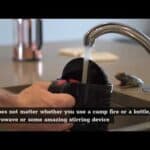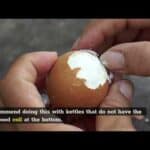Knowing which of these three options is the most efficient way to boiling water for tea or coffee can help you become a better eco-warrior and might even save you a little money. I hope to provide a definitive answer to this question based on some quick measurements and calculations. Looking for the best tea kettles? We have a review you can use as reference.
A large mug holds about 12 ounces, or 350 ml, so I’ll use 350 ml of room-temperature water (17° C). I will use a Black & Decker electric kettle, a General Electric electric stove with a Circulon two-quart saucepan, and a 900W microwave with a turntable. In each case, the electricity consumption will be measured until the water reaches boiling point, or 100° C.
The Electric Kettle
Electric kettles are known for their efficiency, and many of them are labeled as such. The water with electric kettles comes into direct contact with the heating element, there is no pot to heat, and most kettles come with an integrated top. The electric kettle used roughly 1200 watts and boiled the water in 125 seconds, resulting in 0.04 kilowatt-hours (kWh) of power used.
The theoretical energy necessary to heat 350 ml of water to 83° C in 125 seconds is 972 watts, I determined after clearing the cobwebs from my thermodynamic section of my brain. When we divide this by the actual wattage utilized, we get an overall efficiency of 81 percent for boiling water in an electric kettle.
The Stove
The problem with a stove is twofold: the heat must be transferred from the element to the pot, and then the pot needs to warm up before it can transfer the heat to the water. In addition, heat loss is inefficient if a lid isn’t used. This occurs due to convection. Using my 6-inch elements on my stove, I boiled 350 ml of water in 318 seconds and consumed 0.11 kWh, almost four times as much energy as the electric kettle.
In order to heat 350 ml of water by 83° C in 318 seconds, we need 382 watts, which gives us an overall efficiency of only 30.5 percent. There is no doubt that an electric kettle is more efficient than a stove, more than twice as efficient. Perhaps the next time you boil water for pasta, you should heat it in the electric kettle first, and then add it to the pot.
The Microwave Oven
We are not only heating the water, but also the mug to some extent, because the water heated by the microwave will be contained by the mug. When compared to boiling water poured into a room-temperature cup, this will increase the time and energy necessary to bring the water to a boil, but it will also help to keep the water hotter for longer. Despite the fact that the microwave oven was rated at 900 watts, the actual energy consumption was 1350 watts.
The 900 watts are probably the power output of the microwave emitter itself, which would indicate an efficiency of 67 percent just to generate microwaves. In 191 seconds, 15 gallons of water were boiled and 0.07 kWh were consumed. I calculated that the microwave’s actual efficiency of boiling water is 47 percent, which is better than the stove, but still less than the electric kettle.
Additional Considerations When Boiling Water
Regardless of how you boil water, you can maximize efficiency by just boiling what you need. To measure the correct amount, use your mug or invest in an Eco Kettle. If you work in an office, you may believe that filling the electric kettle to the brim is the most effective method, but this is not the case. If the water isn’t used straight away, a lot of the energy will just end up in the air, which your HVAC system will have to remove. After all, heating small batches of water is faster than heating a large amount.
Was this helpful?
Hi there! I’m a food enthusiast and journalist, and I have a real passion for food that goes beyond the kitchen. I love my dream job and I’m lucky enough to be able to share my knowledge with readers of several large media outlets. My specialty is writing engaging food-related content, and I take pride in being able to connect with my audience. I’m known for my creativity in the kitchen, and I’m confident that I can be the perfect guide for anyone looking to take their culinary journey to the next level.









